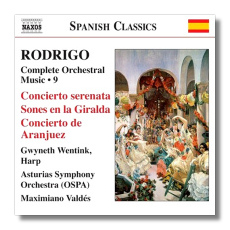
The Internet's Premier Classical Music Source
Related Links
- Rodrigo Reviews
- Latest Reviews
- More Reviews
-
By Composer
-
Collections
DVD & Blu-ray
Books
Concert Reviews
Articles/Interviews
Software
Audio
Search Amazon
Recommended Links
Site News
 CD Review
CD Review
Joaquín Rodrigo

Complete Orchestral Music - Volume 9
- Concierto serenata for Harp & Orchestra
- Sones en la Giralda (Fantasía Sevillana) for Harp & Orchestra
- Concierto de Aranjuez (arr. Harp & Orchestra)
Gwyneth Wentink, harp
Asturias Symphony Orchestra (OSPA)/Maximiano Valdés
Naxos 8.555843 DDD 58:10
With this release, Naxos moves to Volume 9 in their series of Rodrigo's complete orchestral music, thereby proving that there's more to this composer than the inescapable Concierto de Aranjuez. "But wait," you say, "isn't the Concierto de Aranjuez here on this very same CD?" Right you are, but it is here with a difference. Although it originally was composed for guitar and orchestra, of course, Rodrigo created a version of this work for harp and orchestra in 1974 for his friend, the Basque harpist Nicanor Zabaleta. This later version is recorded far less often – in fact, the only other recording I've heard is an LP by Zabaleta himself on EMI/Angel – so it is welcome here. Having said that, I have to say that the guitar original works better, because that instrument is capable of a greater emotional range. Percussive effects easily created on the guitar don't work nearly as well on the harp.
The Concierto serenata (1952) also is associated with Zabaleta. In this work, Rodrigo exploits the harp's seraphic timbre, and hearing a good performance is like taking a 25-minute spin on a pair of rented angel wings. As stated in Graham Wade's booklet notes, the composer claimed that he wanted to "make the entire work light, clear, and joyful, like the harp's child-like soul." His success was complete. It is impossible to be unhappy while listening to this work.
The title Sones en la Giralda (1963) is an allusion to the ancient cathedral in the city of Seville, and specifically to its tower. Just nine minutes long, this is more a tone poem than a concerto. It is not as immediately appealing as the other two works, but it is a good example of how Rodrigo's style became more impressionistic later in his career. This work was composed for another famous harpist, Marisa Robles.
Dutch harpist Gwyneth Wentink, still in her 20s, is neither a Robles nor a Zabaleta, although in time she may well be. My only real reservation about her performances here is that they are a little soft around the edges; Zabaleta's playing is more incisive, with firmer outlines. Similarly, the Asturias Symphony Orchestra, established in 1937, is not quite a front-rank ensemble, mostly because their timbre is neither as rich nor as refined as that of, for example, the Spanish National Orchestra. Valdes, their principal conductor, directs the music sensibly, and overall, if one is not bowled over by the playing of either the orchestra or the soloist, neither is one bothered by it. In the absence of Zabaleta's own recording of the Concierto de Aranjuez, this Naxos release can be safely recommended to anyone who is curious to know what this work sounds like on the harp. (Zabaleta's DG recording of the Concierto serenata is not to be missed - Deutsche Grammophon 469190-2.) Good sound.
Copyright © 2007, Raymond Tuttle




















